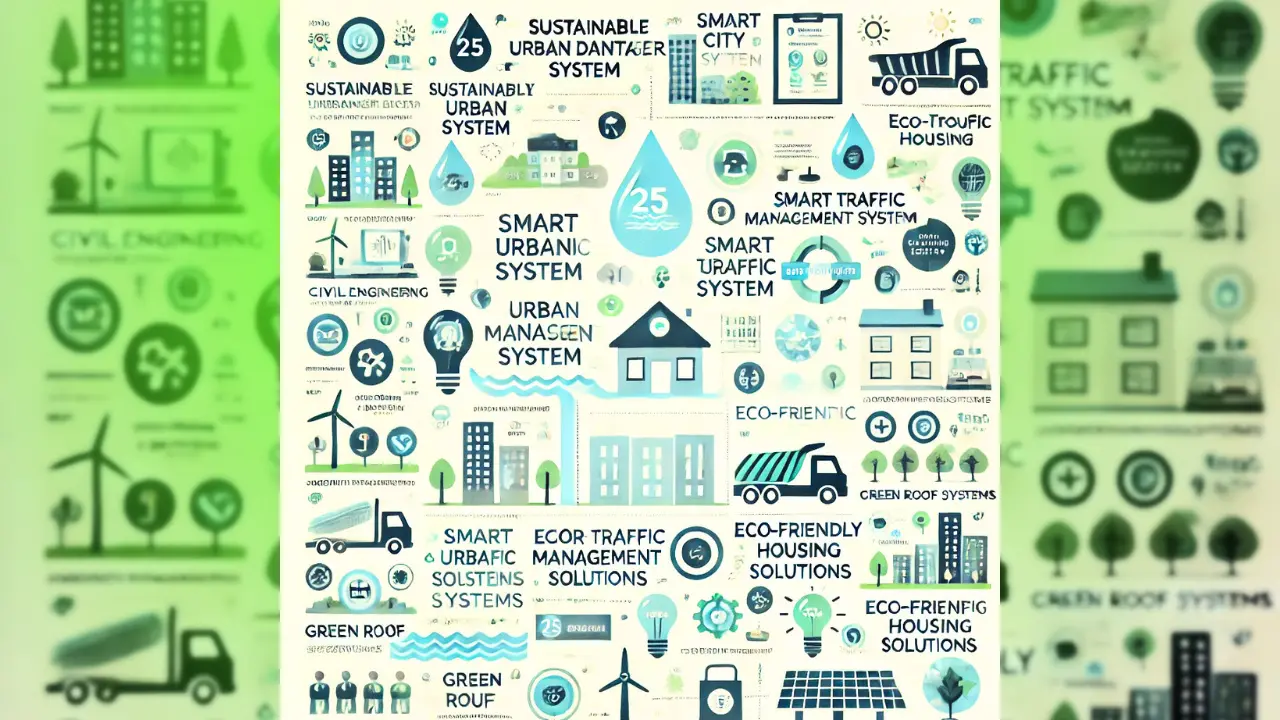Table of Contents
Best Civil Engineering Project ideas 💡
In a world facing rapid urbanization, climate change, and resource constraints, civil engineers are essential to designing solutions that support resilient, sustainable, and safe communities. Whether you’re a student or a professional looking to make an impact, selecting the right civil engineering project idea can lay the foundation for a meaningful contribution. Here are 25 civil engineering project ideas that not only push the boundaries of innovation but also address some of society’s most pressing needs.

1. Sustainable Urban Drainage System (SUDS) Design
- Description: Develop a drainage system to mitigate flooding risks, improve water quality, and support groundwater recharge in urban areas.
- Importance: Helps cities manage increased rainfall and prevent urban flooding.
2. Eco-Friendly and Affordable Housing Solutions
- Description: Create sustainable, low-cost housing using recycled materials or alternative construction methods like prefab homes or shipping container conversions.
- Importance: Addresses housing shortages while minimizing environmental impact.
3. Smart Traffic Management System Using IoT
- Description: Implement a smart system with sensors and IoT to analyze traffic patterns and reduce congestion in real-time.
- Importance: Improves road efficiency and reduces emissions, a critical need in urban areas.
4. Green Roof and Wall Systems for Buildings
- Description: Design green roof systems or vertical gardens to reduce building temperatures, improve air quality, and add aesthetic value.
- Importance: Mitigates the urban heat island effect and enhances cityscape greenery.
5. Recycled Asphalt Pavement (RAP) for Road Construction
- Description: Use recycled asphalt materials to build durable, low-cost roads.
- Importance: Reduces the demand for raw materials and lowers the carbon footprint of road construction.
6. Earthquake-Resistant Structures for High-Seismic Zones
- Description: Develop building designs that incorporate materials and structures to withstand seismic activity.
- Importance: Protects lives and infrastructure in earthquake-prone areas.
7. Engineered Cementitious Composite (ECC) for Structural Repair
- Description: Use ECC, a flexible and durable material, to retrofit or repair existing structures.
- Importance: Extends the lifespan of aging structures, reducing costs and environmental impact.
8. Flood-Resilient Building Design
- Description: Design buildings with features that protect against flood damage, like elevated foundations and waterproofing.
- Importance: Essential for flood-prone regions affected by climate change.
9. Bridge Health Monitoring System Using IoT Sensors
- Description: Install IoT sensors to monitor bridge integrity, detecting cracks, stress levels, and other risks.
- Importance: Improves safety and reduces maintenance costs through predictive monitoring.
10. Water Treatment Using Natural Filtration
- Description: Design a natural water filtration system using plants and soil layers to purify water for drinking or irrigation.
- Importance: Provides a sustainable water purification method, especially valuable in rural areas.
11. Noise Barrier Installation for Urban Highways
- Description: Build noise barriers along highways using materials that absorb or deflect sound, such as recycled rubber.
- Importance: Reduces noise pollution, improving the quality of life for nearby residents.
12. Smart Waste Management Systems
- Description: Design IoT-enabled waste collection bins that alert municipal authorities when they need to be emptied.
- Importance: Improves waste management efficiency and reduces city litter.
13. Solar-Powered Roadways
- Description: Implement solar panels on road surfaces to generate electricity and power streetlights or signals.
- Importance: Offers a dual-purpose infrastructure solution for energy generation and transportation.
14. Bio-Retention Systems for Stormwater Management
- Description: Design bio-retention areas like rain gardens to manage stormwater runoff naturally.
- Importance: Reduces stormwater pollution and improves water infiltration.
15. Carbon Footprint-Reducing Concrete
- Description: Develop concrete with a lower carbon footprint by replacing some cement content with alternative materials like fly ash or GGBS.
- Importance: Essential for lowering emissions in construction projects.
16. IoT-Based Home Automation for Energy Efficiency
- Description: Create an IoT-based system to monitor and optimize energy usage in buildings.
- Importance: Enhances energy efficiency, helping reduce household or commercial energy bills.
17. Permeable Pavement for Rainwater Harvesting
- Description: Use permeable pavement materials that allow rainwater to infiltrate the ground, reducing runoff.
- Importance: Helps recharge groundwater and manage stormwater naturally.
18. Retrofitting Bridges with Fiber-Reinforced Polymer (FRP)
- Description: Use FRP materials to strengthen aging bridges, improving their durability and load capacity.
- Importance: Extends bridge life spans, reducing maintenance costs and enhancing public safety.
19. Development of Smart Parking Systems
- Description: Design a parking system that uses sensors to track available spaces and direct drivers accordingly.
- Importance: Reduces urban congestion caused by drivers searching for parking.
20. Coastal Erosion Control Solutions
- Description: Design eco-friendly solutions for coastal erosion, like artificial reefs or sea walls using sustainable materials.
- Importance: Protects coastal regions from erosion, safeguarding communities and ecosystems.
21. Wind-Resistant Building Design
- Description: Develop building designs that withstand high-wind conditions through materials and architectural design.
- Importance: Essential for regions prone to hurricanes and typhoons.
22. Automated Construction using Drones and Robotics
- Description: Create a system where drones and robots assist in the construction process, performing tasks like surveying or material delivery.
- Importance: Increases efficiency and safety in construction sites, especially in remote areas.
23. Green Concrete Using Waste Materials
- Description: Develop concrete that incorporates waste materials like brick powder, recycled glass, or plastic waste.
- Importance: Reduces waste in landfills and provides a sustainable construction material.
24. Solar-Powered Desalination Plant
- Description: Design a desalination plant that uses solar energy to convert seawater into potable water.
- Importance: Provides an eco-friendly solution for water scarcity, especially valuable in coastal and arid regions.
25. Automated Road Repair System Using AI and Robotics
- Description: Develop an AI-guided robotic system that detects and repairs potholes and cracks in roads automatically.
- Importance: Improves road safety and reduces long-term maintenance costs by addressing damage early.
Conclusion
These civil engineering project ideas not only address various societal challenges but also open pathways for a more sustainable, efficient, and resilient future. By adopting a problem-solving mindset and focusing on innovation, civil engineers can continue to transform communities and positively impact the environment. From sustainable building materials to smart urban solutions, each project idea here represents an opportunity to create a meaningful and lasting change.

Hi! I’m Sandip, a civil engineer who loves sharing about Civil Engineering & new ideas and tips. My blog helps you learn about engineering in a fun and easy way!


“Standing ovation! 🌠 This post perfectly balances depth with accessibility. Your thorough research and expert explanations make this an invaluable resource. Keep up the amazing work!”